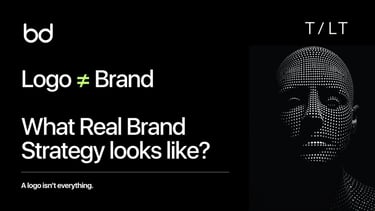Your Brand Is Not Your Logo: What Real Brand Strategy Looks Like
Your logo is not your brand. Your colours are not your brand. Your website is not your brand. These are expressions of your brand, not the brand itself. This blog breaks down what real brand strategy looks like and why it’s the engine that drives long-term growth, differentiation, and customer trust.
Brand Blinks Global
4 min read


Your logo is not your brand. Your colours are not your brand. Your website is not your brand.
These are expressions of your brand, not the brand itself.
Yet, many businesses believe branding starts and ends with a logo, tagline, and design templates. They invest in the aesthetics of the brand without ever defining the strategy. That’s like building the front door of a house before laying its foundation.
This blog breaks down what real brand strategy looks like and why it’s the engine that drives long-term growth, differentiation, and customer trust.
The Problem: When You Confuse Design With Brand Strategy
Imagine you’re launching a tech startup.
You:
Hire a designer for a modern logo
Choose a bold colour palette
Build a stylish website
Start running social media ads
It looks like a brand. But six months later, growth stalls. Customers don’t remember you. There's no loyalty. Your acquisition cost rises. Retention drops.
Why?
Because without a strategy, all the visuals in the world won’t make people care.
Real Brand Strategy Is Business Strategy
Branding is not just a visual identity. It’s a decision-making framework.
A real brand strategy defines:
Who you serve
What problem do you solve
Why your brand matters
How you act, speak, and deliver consistently
It is the foundation of everything: your positioning, messaging, customer journey, team alignment, and growth model.
Without it, you’re not building a brand. You’re just dressing up a product.
What Real Brand Strategy Looks Like
Here are the components of a strong brand strategy that go far beyond logos and design:
1. Brand Purpose and Vision
Why does your business exist beyond profits?
Example: “To simplify nutrition for busy professionals through real science and clean products.”
A clear purpose drives culture, decision-making, and long-term relevance.
2. Audience Clarity
Who exactly are you targeting?
This should go beyond demographics. Understand:
Needs and motivations
Frustrations and barriers
Buying behaviour and priorities
Emotional and practical drivers
Real brand strategy narrows the focus so you speak directly and powerfully to someone, not everyone.
3. Positioning
What makes you different and valuable in the market?
Positioning is the heart of your brand. It answers:
What makes us the best choice?
What do we offer that others don’t?
What is our unique advantage?
Example: “We are the only analytics platform built for non-technical teams in e-commerce.”
Good positioning is not about being better. It’s about being different in a way that matters to your audience.
4. Messaging Framework
Your messaging needs consistency, not improvisation.
Key elements include:
Brand story
Elevator pitch
Value propositions
Taglines and headline variations
Your message should come from strategy, not trend or opinion.
5. Brand Personality and Voice
How does your brand sound and behave?
Define:
Your tone of voice across touchpoints
Words you always use and avoid
The personality traits that guide communication
This ensures alignment from your homepage to your sales deck.
6. Visual Identity Informed by Strategy
Only after defining the above should you design:
Logo
Color system
Typography
Visual guidelines
Templates and design assets
A visual identity that is not informed by strategy becomes decoration, not differentiation.
7. Customer Experience Strategy
Your brand lives in every touchpoint.
Make sure your strategy flows into:
Onboarding
Emails and retention campaigns
Packaging and unboxing
Support and service language
Community and referrals
Every step should reflect your positioning, voice, and promise.
Why Strategy Must Come Before Design
Design without strategy leads to:
Generic messaging
Misaligned visuals
Inconsistent campaigns
Wasted ad spend
Weak retention
On the other hand, strategy-led brands:
+ Convert faster
+ Create loyalty
+ Reduce acquisition costs
+ Attract better customers
+ Scale with more clarity
Your logo might get attention. But only a strategy builds trust.
Common Signs of a Strategy Gap
Everyone on the team explains the brand differently
Your value proposition feels vague or interchangeable
You’re constantly changing direction
Campaigns look good, but don’t perform
Prospects say they “don’t get what you do”
These are not marketing problems. They are strategy problems.
A Real-World Example
A fast-growing SaaS startup invested heavily in design early on a sleek website, custom illustrations, and bold colour themes. But customers churned quickly, and they struggled to scale campaigns.
The issue?
They had no defined audience, unclear positioning, and no messaging strategy.
Once they implemented a brand strategy foundation with audience clarity, positioning, and messaging, their conversion rates increased, and customer lifetime value improved significantly.
In Practice: The BRNDx Method
At Brand Blinks Global, we help businesses unlock brand-led growth through a structured framework called BRNDx:
+ Business and brand alignment
+ Real audience definition
+ Narrative and messaging
+ Distinct positioning
+ Experience design and brand systems
This process ensures brands don’t just look premium, they become more meaningful, more consistent, and more scalable.
How We Build a Strategy-Led Brand
Start with a brand audit. Identify what’s missing, inconsistent, or unclear.
Define your core. Clarify your purpose, vision, audience, and positioning.
Build a messaging and voice system. Use it to guide content, sales, and campaigns.
Design a visual identity based on research, not trend-based design, but intentional brand expression.
Integrate brand into every touchpoint. From onboarding to email, your strategy must guide all communication and experience.
Your Brand Is Not What You Say. It's What They Feel.
People don’t buy logos. They buy clarity. They buy meaning. They buy trust.
If your brand feels fragmented, misunderstood, or generic, the problem isn’t the design. It’s the absence of planning.
A real brand starts with strategy. Everything else follows.







© 2025 BRNDXMORPH Media Worldwide Private Limited. All rights reserved.
Brand Blinks Global® | BBG is an independent global brand consulting and transformation company.
The trademarks, logos, and service marks displayed on this site are the property of their respective owners.
"Brand Blinks Global®," "Brand Blinks®," "Made for the Uncommon®," and the "bd®" logo are trademarks or registered trademarks of BRNDXMORPH Media Worldwide Private Limited.
RESOURCES
INTELLIGENCE
BUSINESS
PARTNER
COVERAGE
EXPLORE
Made for the Uncommon®


When your brand grows, others rise too. 2% of your project empowers a nonprofit we back together every year.


